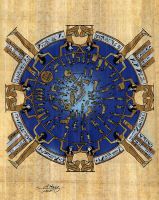For example, in the city of San Francisco for 2009, on the date of August 6 Sirius rises at 5.45a and the time for beginning Civil Twilight is 5.49. That means that on that date the human eye will see Sirius just 4 minutes before Twilight begins. Once the suns actually rises at 6.18a it will be far too bright to see the star.
The date of New Year will vary considerably, depending on latitude and longitude in our very large country.
For example, in Miami, Florida, the date for New Year 2009 will be July 27 – and not August 6 as in San Francisco – because Civil Twilight begins at 6.20a and Sirius rises at 6.16a, just four minutes prior. That means Sirius will be visible for the first time in this season. On dates prior to July 27 Sirius will be rising after the start of Civil Twilight and Sunrise and hence will not be seen by the naked eye because the sky will be too bright.
This does raise some issues that could to be explored by the various Kemetic temples. Would it be “within the Tradition” to have such variation in celebrating the new year across this country? Would it be better to select one date for the nation or for a fellowship of affiliated temples, even though they’re geographically far apart?
Might we use the date based on calculations for Egypt instead of the United States? And, if so, which location in Egypt–since Egypt is also a very large country?
You see, the questions multiply.
My sense of things is that we are not wrong to use our own location in determining the date for Wep Renpet. Human’s experience of their world is in fact local, not global. The sun rises for us in our location at a certain time, and for other folks in their locations at different times. On the other hand, perhaps we Kemetics should select one location – let’s say, the nation’s capital – to calculate the date of Wep Renpet. At this very early stage in our development as Kemetic Reconstructionists I think we can begin a period of reflection and discussion on the topic–in a spirit of mutual respect for the varying insights and opinions that will likely emerge. Just as in ancient Kemet there were a number of differing creation myths, and all were honored, so today we can learn from their example to honor diversity of opinion.
You may like to read Jeremy Naydler’s Temple of the Cosmos, pages 67-73 about Sirius’s role. Several thousand years ago I believe the rising of Sopde (or Sopdet, i.e. Sirius) would have occurred earlier, in late June or July. Due to celestial movements, however, today it occurs in late July or early August.
Determining if there will be an extra intercalary month in any given year
We know that the ancient Egyptian religious calendar placed the beginning of a new year on the day where the heliacal rising of Sopdet (the star Sirius) occurs just before sunrise after a period of invisibility lasting approximately seventy days. We also know that the religious calendar was a lunar calendar, with the New Moon being regarded as the first day of the month. The following question comes up: how did the ancient Egyptians coordinate the rising of Sopdet with the waxing and waning of the moon? Rarely does the rising of Sopdet fall precisely on the day of the New Moon. In fact, such an occurrence would be quite rare. That means Wep Renpet (new year day) would most likely occur some days before a New Moon. What becomes of those days? The solution apparently employed by the ancient Egyptian priesthood was to add a thirteenth lunar month — rather than the standard twelve — to the new year. Today this is referred to as an intercalary month. If New Moon occurs within less than 11 days of the heliacal rising of Sopdet then that extra intercalary month becomes the first lunar month of the new year. The Egyptologist Richard Parker thought that this extra month occurred just about every three years. The ancient Egyptians dedicated it to Djehuty and it continues to bear this god’s name.
Today, as we attempt to restore and revive an authentic Kemetic festival calendar we need to keep these two factors in mind: 1) the appearance of Sopdet immediately before sunrise; and 2) the accurate periodic inclusion of that extra month at the start of the year. Once we determine those two conditions we will then be able to create our annual religious calendar beginning with the four-month cycles of Akhet (3ht), followed by the four months of Peret (prt), and the four months of Shomu (smw). In 2009, for example, in the San Francisco Bay Area the feast of Wep Renpet occurred on August 6, with another 14 days before New Moon. Consequently, that year did not have that extra intercalary month, but instead began with the month of Tekhy, considered the first lunar month of the new year.
For anyone interested in learning more about the calendars of ancient Egypt the following books will be helpful:
Temple Festival Calendars of Ancient Egypt, by Sherif El-Sabban (Liverpool Univ. Press, 2000).
The Calendars of Ancient Egypt, by Richard A. Parker (Chicago, 1950).
Revolutions in Time: Studies in Ancient Egyptian Calendrics, ed. by Anthony J. Spalinger (San Antonio, TX, 1994).
©2011 Richard Reidy
This material is copyrighted. All rights reserved.
• In top toolbar click on ‘Astronomy’
• Then click on Data Services
• Click on Rise/Set/Transit Times for Major Solar System Objects and Bright Stars
• Fill out the required fields, including your location, the star Sirius, and dates from late July to August 14 or later.
• Print a copy of the resulting table of Rise/Set/Transit Times.
• Then go back and fill out the form again, but this time you will select Sun so you can get Rise/Set/Transit Times for the sun.
• Finally, compare the two sets of Times, remembering that you are looking for the first date when Sirius appears BEFORE Civil Twilight.
Go to http://www.usno.navy.mil

The religious calendar of ancient Kemet is both lunar–with each month starting on the day of the New Moon – as well as sidereal – with the New Year – called ‘Wep Renpet’ or the Opening of the Year – celebrated on the morning of the visible rise of Sopdet (Sirius) just prior to sunrise.
To determine the date for the beginning of the New Year we need to calculate the precise date that the star Sirius (called ‘Sopdet’ in Egyptian) rises just before sunrise. Sirius had been invisible for some 70 days – which means it arose when the sun had already risen and hence could not be seen by the naked eye due to the illuminated atmosphere.
Today we can utilize a government astronomical website that provides us with the necessary information. Here’s what to do :
by Richard Reidy
Religious Calendar of Ancient KMT
ARTICLES
Price : $15.00
The Kemetic Temple of San Jose is offering a CD of the General Ritual for Sekhmet recited by temple members and author Richard Reidy. This ritual is based on ancient temple texts & appears in Eternal Egypt: Ancient Rituals for the Modern World. The ritual is a beautiful, meditative journey into the heart of ancient worship. All proceeds from the CD go for temple expenses.
This beautiful CD costs $15 (price incl. shipping in the U.S.)
hear a sample

SEKHMET
Ritual Recording








For questions about Kemeticism, our Kemetic Temples, and Kemetic Reconstructionism,